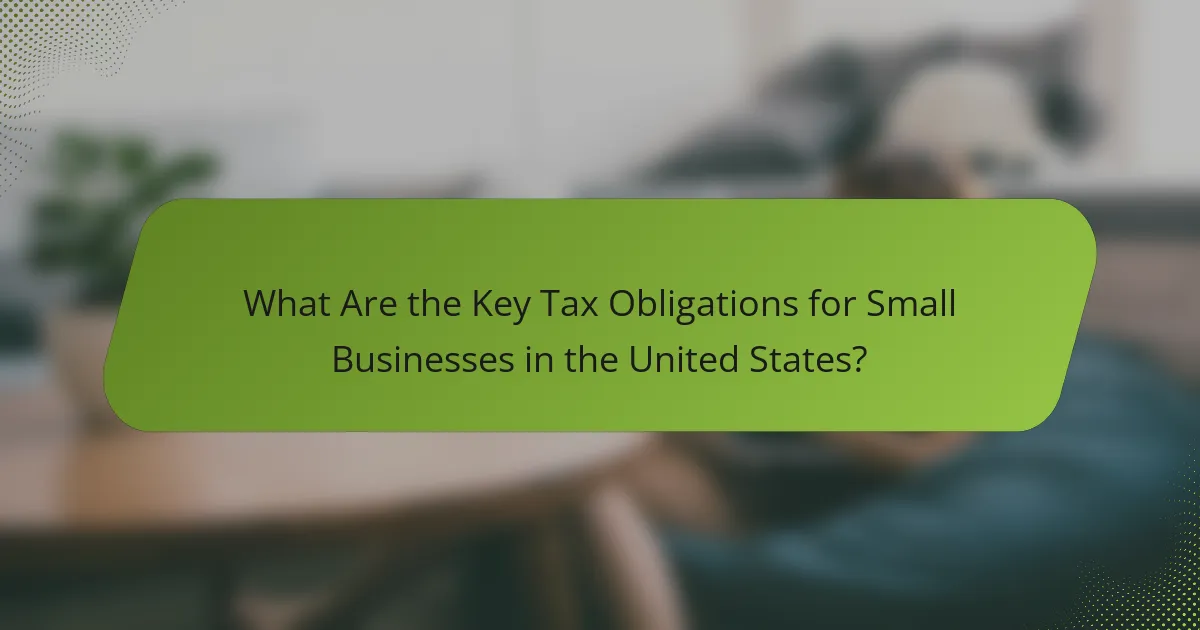Small businesses in the United States have specific tax obligations that are crucial for maintaining compliance and ensuring financial stability. By understanding these obligations, including the impact of business structure and available deductions, owners can effectively manage their finances and minimise potential penalties.

What Are the Key Tax Obligations for Small Businesses in the United States?
Small businesses in the United States face several key tax obligations that are essential for compliance and financial health. Understanding these obligations helps business owners manage their finances effectively and avoid penalties.
Federal income tax
Federal income tax applies to the profits earned by small businesses, and the rate may vary depending on the business structure. Sole proprietorships, partnerships, and S corporations typically pass income through to owners, who report it on their personal tax returns, while C corporations are taxed separately at the corporate level.
Business owners should keep accurate records of income and expenses to determine taxable income. Deductions can significantly reduce the amount owed, so it’s crucial to understand what qualifies as a deductible expense.
Self-employment tax
Self-employment tax is applicable to individuals who work for themselves, covering Social Security and Medicare taxes. This tax is calculated based on net earnings from self-employment, and the current rate is approximately 15.3% on income up to a certain threshold.
Small business owners should be aware that they can deduct the employer-equivalent portion of self-employment tax when calculating their adjusted gross income. This deduction can help lower overall tax liability.
Payroll tax
If a small business has employees, it must withhold payroll taxes from their wages, which include Social Security, Medicare, and federal income tax. Employers are also responsible for paying a portion of these taxes, making payroll tax compliance crucial for business operations.
To avoid penalties, businesses should regularly deposit withheld taxes and file required payroll tax returns. Utilising payroll software or services can streamline this process and ensure accuracy.
Sales tax
Sales tax is imposed on the sale of goods and certain services, and it varies by state and locality. Small businesses must register for a sales tax permit in their state and collect the appropriate sales tax from customers at the point of sale.
It’s important to understand the specific sales tax rates and regulations in your area, as failure to collect or remit sales tax can lead to significant penalties. Keeping thorough records of sales and taxes collected is essential for compliance.
Estimated tax payments
Small business owners may need to make estimated tax payments throughout the year if they expect to owe a certain amount in taxes. These payments help avoid underpayment penalties and are typically due quarterly.
To calculate estimated taxes, business owners should estimate their expected income and tax liability for the year. Using IRS Form 1040-ES can assist in determining the correct payment amounts. Staying on top of these payments can prevent financial strain at tax time.

How Do Small Businesses File Taxes?
Small businesses in the United States typically file taxes based on their business structure, which determines the forms and methods used. Understanding the specific requirements for each structure is essential to ensure compliance and optimise tax obligations.
Using Form 1040 Schedule C
For sole proprietorships, filing taxes involves using Form 1040 Schedule C. This form allows business owners to report income and expenses directly on their personal tax returns. It’s important to keep detailed records of all business-related expenses to maximise deductions.
Common deductions on Schedule C include costs for supplies, utilities, and business travel. Ensure that all expenses are ordinary and necessary for your business to qualify for deductions. Filing this form is generally straightforward, but accuracy is crucial to avoid audits.
Filing as an S Corporation
S Corporations file taxes using Form 1120S, which allows income to pass through to shareholders without being taxed at the corporate level. This structure can provide tax advantages, such as avoiding double taxation on dividends. However, S Corporations must adhere to specific eligibility requirements, including limits on the number of shareholders.
Shareholders report their share of the income on their personal tax returns using Schedule K-1, which is provided by the corporation. It’s vital to maintain proper records and comply with IRS regulations to retain S Corporation status and avoid penalties.
Filing as a Partnership
Partnerships file taxes using Form 1065, which reports the income, deductions, and credits of the partnership. Like S Corporations, partnerships are pass-through entities, meaning profits are taxed only at the individual partner level. Each partner receives a Schedule K-1 detailing their share of the income.
Partners should keep meticulous records of all transactions and distributions to ensure accurate reporting. It’s also important to establish a partnership agreement that outlines each partner’s responsibilities and profit-sharing arrangements to prevent disputes and ensure compliance with tax obligations.

What Are the Deductions Available for Small Businesses?
Small businesses in the United States can take advantage of various tax deductions to reduce their taxable income. Understanding these deductions can significantly impact a business’s overall tax liability and financial health.
Business expenses
Business expenses encompass a wide range of costs necessary for operating a business, including rent, utilities, supplies, and salaries. These expenses can be deducted from gross income, lowering the taxable amount. It’s crucial to keep detailed records and receipts to substantiate these deductions during tax filing.
Common deductible business expenses include office supplies, advertising costs, and professional services. For example, if a business spends $5,000 on marketing and $2,000 on office supplies, these amounts can be deducted, directly reducing taxable income.
Home office deduction
The home office deduction allows small business owners to deduct expenses related to the portion of their home used exclusively for business purposes. This can include a percentage of rent or mortgage interest, utilities, and home insurance. To qualify, the workspace must be used regularly and exclusively for business activities.
To calculate the deduction, you can use the simplified method, which allows a deduction of £5 per square foot of home office space, up to a maximum of 300 square feet. Alternatively, the actual expense method requires tracking specific expenses related to the home office.
Vehicle expenses
Small business owners can deduct vehicle expenses incurred while using their vehicles for business purposes. There are two methods to calculate this deduction: the standard mileage rate or actual expenses. The standard mileage rate is a set amount per mile driven for business, while actual expenses include fuel, maintenance, and depreciation.
For 2023, the standard mileage rate is approximately 65.5 pence per mile. If a business owner drives 10,000 miles for business, they could deduct around £6,550 using the standard mileage method. Keeping a detailed log of business mileage is essential for accurate reporting.

What Are the State-Specific Tax Obligations?
State-specific tax obligations for small businesses in the United States vary significantly by location. Each state has its own tax regulations, rates, and filing requirements that business owners must understand to remain compliant.
California tax requirements
In California, small businesses are subject to various taxes, including the California corporate income tax, which is generally set at 8.84% for corporations. Additionally, businesses must pay a minimum franchise tax of $800 annually, regardless of income.
Sales tax in California is also a consideration, with a base rate of 7.25%, though local jurisdictions can increase this rate. Business owners should register for a seller’s permit if they sell tangible goods, ensuring they collect and remit sales tax appropriately.
Texas tax requirements
Texas does not impose a state income tax on businesses, making it attractive for small business owners. However, businesses must pay a franchise tax, which is based on revenue and varies depending on the amount, with rates typically ranging from 0.375% to 0.75%.
Additionally, Texas requires businesses to collect sales tax, currently at a rate of 6.25%, with local jurisdictions potentially adding more. Registering for a sales tax permit is necessary for compliance when selling taxable goods or services.
New York tax requirements
In New York, small businesses face a corporate income tax that varies based on revenue, with rates ranging from 6.5% to 7.25%. Additionally, businesses must pay a minimum tax based on their gross receipts, which can start as low as £25 for smaller entities.
Sales tax in New York is set at 4%, but local counties can add up to 4.5%, making the total rate as high as 8.875% in some areas. Businesses selling goods must obtain a sales tax certificate and ensure proper collection and remittance of sales tax.

What Are the Common Mistakes Small Businesses Make with Taxes?
Small businesses often make critical mistakes with taxes that can lead to penalties and financial loss. Understanding these common errors can help business owners avoid costly pitfalls and ensure compliance with tax regulations.
Failing to keep accurate records
Accurate record-keeping is essential for small businesses to manage their tax obligations effectively. Without proper documentation, businesses may struggle to substantiate their income and expenses, leading to potential audits and penalties.
To maintain accurate records, businesses should track all financial transactions, including sales, expenses, and payroll. Utilising accounting software can streamline this process and help ensure that all necessary documents are organised and readily available when tax season arrives.
Misclassifying employees
Misclassifying employees as independent contractors is a common mistake that can have significant tax implications. This error can result in unpaid payroll taxes, penalties, and interest, as businesses are responsible for withholding taxes for employees but not for contractors.
To avoid misclassification, businesses should clearly understand the differences between employees and independent contractors based on IRS guidelines. Factors such as control over work, financial arrangements, and the relationship’s nature should be carefully considered when determining a worker’s classification.
